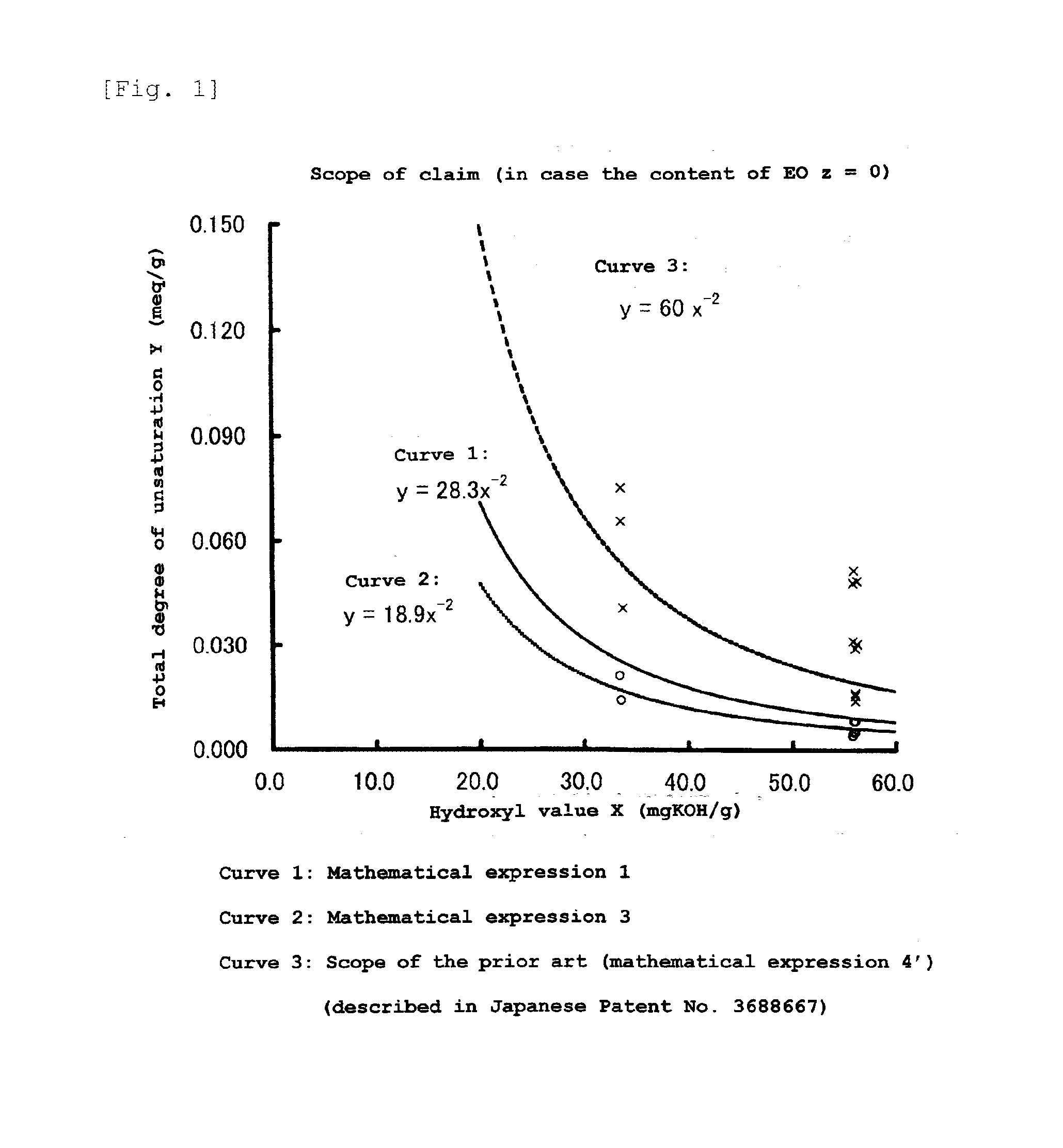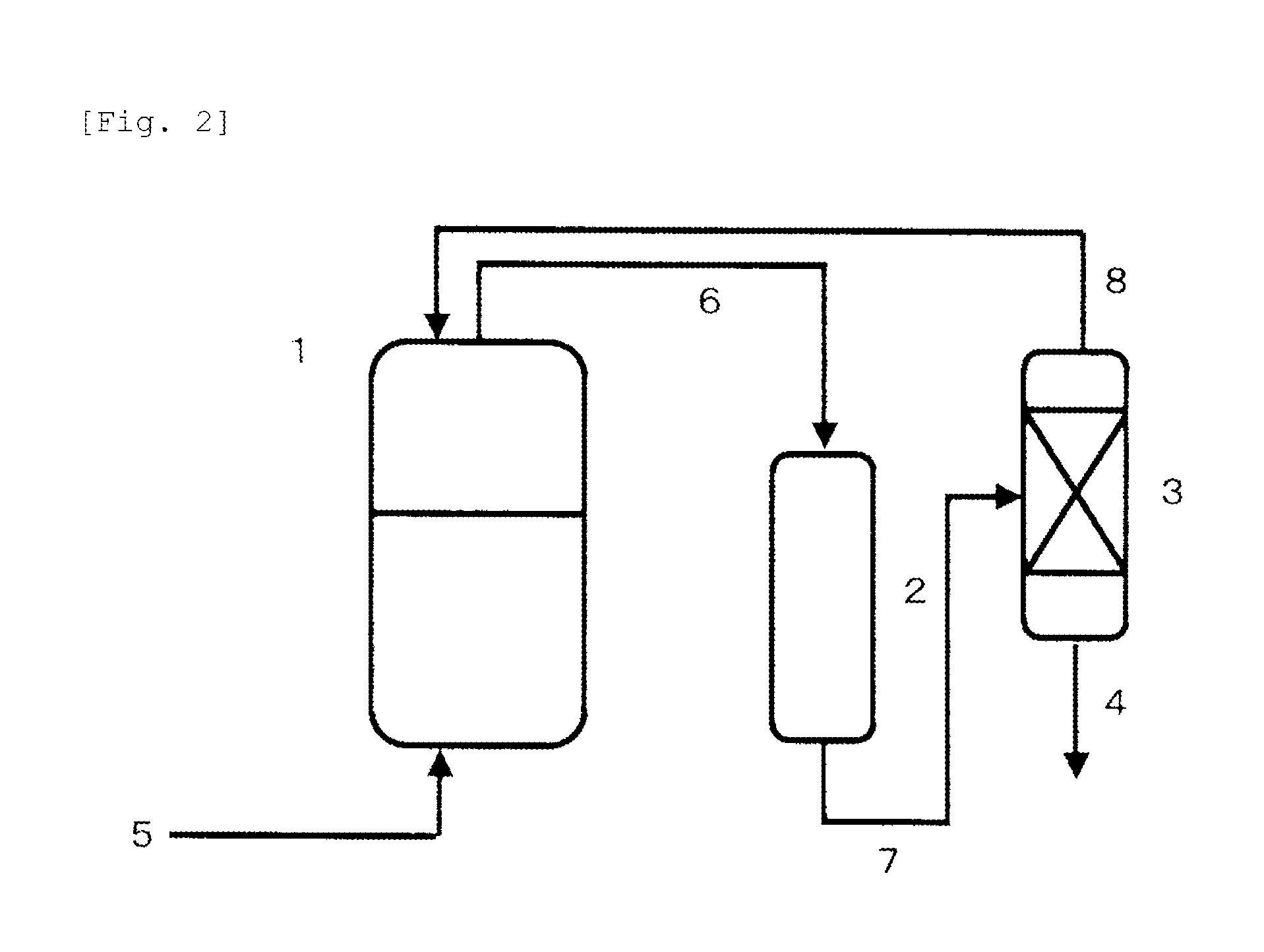Polyoxyalkylene polyol or monool and polyurethane resin
a polyol or monool and polyurethane technology, applied in the field of polyoxyalkylene polyol or monool, and a polyurethane resin, can solve the problems of insufficient reactivity of polyol, decrease in the number of functional groups, and deterioration of mechanical properties, so as to achieve satisfactory mechanical properties and moisture resistance, satisfactory mechanical properties, and sufficient reactivity
- Summary
- Abstract
- Description
- Claims
- Application Information
AI Technical Summary
Benefits of technology
Problems solved by technology
Method used
Image
Examples
example 1
[0129]Like the aspect shown in FIG. 2, an autoclave made of stainless steel as a reaction vessel (1) (having a capacity of 2500 ml) equipped with a stirrer, a temperature control device and a raw material supply line (5) was connected to a reaction column (2) (using two cylindrical tubes made of stainless steel, each measuring 5.5 cm in inner diameter and 30 cm in length) filled with 400 parts of magnesium oxide (granules, diameter of 2 to 0.1 mm) and a distillation column (3) (theoretical plate number of 30, cylindrical tube made of stainless steel, 5.5 cm in inner diameter and 2 m in length) through circulation lines (6), (7), (8).
[0130]In the reaction vessel (1), 400 g of a PO adduct of glycerin (hydroxyl value of 280) and 0.09 g of tris(pentafluorophenyl) borane were charged, and then each pressure in the autoclave {reaction vessel (1)} and the reaction column (2), and the circulation lines (6), (7), (8) was reduced to 0.005 MPa. While continuously charging PO in a liquid phase ...
example 2
[0132]Like the aspect shown in FIG. 3, an autoclave made of stainless steel as a reaction vessel (1) (having a capacity of 2500 ml) equipped with a stirrer, a temperature control device and a raw material supply line (5) was connected to a distillation column (3) (theoretical plate number of 50, cylindrical tube made of stainless steel, 5.5 cm in inner diameter and 3 m in length) through circulation lines (6), (8).
[0133]In the reaction vessel (1), 400 g of a PO adduct of glycerin (hydroxyl value of 280) and 0.09 g of tris(pentafluorophenyl) borane were charged, and then each pressure in the autoclave {reaction vessel (1)} and the reaction column (2), and the circulation lines (6), (8) was reduced to 0.005 MPa. While continuously charging PO in a liquid phase through the raw material supply line (5) with controlling so as to maintain the reaction temperature at 50 to 60° C., a vapor phase in the reaction vessel (1) was circulated at a flow rate of 5 L / minute in the order of the react...
example 3
[0135]Like the aspect shown in FIG. 4, an autoclave made of stainless steel as a reaction vessel (1) (having a capacity of 2500 ml) equipped with a stirrer, a temperature control device and a raw material supply line (5) was connected to an adsorption column (9) (cylindrical tube made of stainless steel, 5.5 cm in inner diameter and 30 cm in length) filled with 500 parts of molecular sieve 4A through circulation lines (6), (8).
[0136]A PO adduct (400 g) of glycerin (hydroxyl value of 280) and 0.09 g of tris(pentafluorophenyl) borane were charged, and then each pressure in the autoclave {reaction vessel (1)} and the adsorption column (9), and the lines (6), (8) was reduced to 0.005 MPa. While continuously charging PO through the raw material supply line (5) with controlling so as to maintain the reaction temperature at 50 to 60° C., a vapor phase in the reaction vessel (1) was circulated at a flow rate of 5 L / minute in the order of the reaction vessel (1)→the vacuum line (6)→the adsor...
PUM
| Property | Measurement | Unit |
|---|---|---|
| hydroxyl value | aaaaa | aaaaa |
| pressure | aaaaa | aaaaa |
| boiling point | aaaaa | aaaaa |
Abstract
Description
Claims
Application Information
 Login to View More
Login to View More - R&D
- Intellectual Property
- Life Sciences
- Materials
- Tech Scout
- Unparalleled Data Quality
- Higher Quality Content
- 60% Fewer Hallucinations
Browse by: Latest US Patents, China's latest patents, Technical Efficacy Thesaurus, Application Domain, Technology Topic, Popular Technical Reports.
© 2025 PatSnap. All rights reserved.Legal|Privacy policy|Modern Slavery Act Transparency Statement|Sitemap|About US| Contact US: help@patsnap.com



